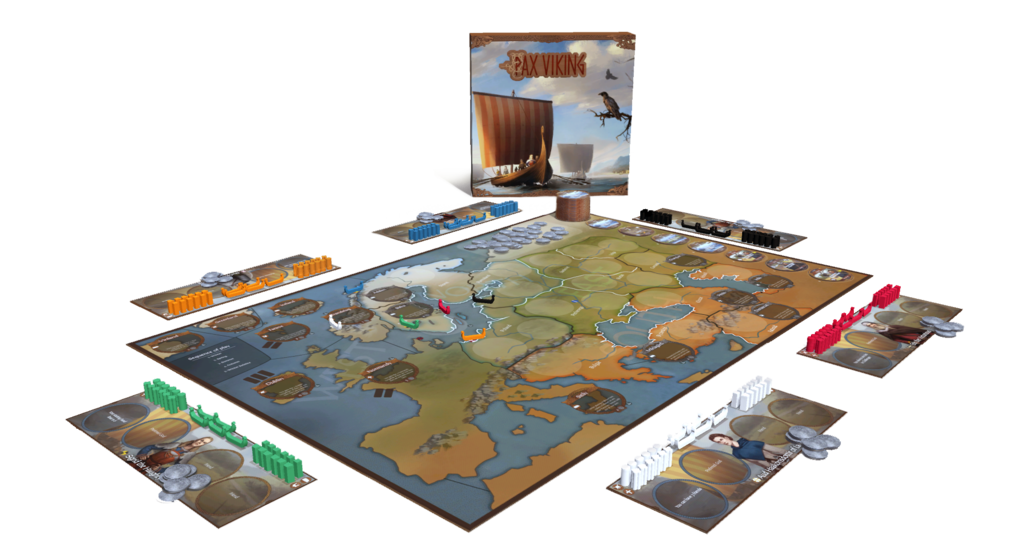Ahhhhhhh the Pax series of games: complex, interactive, with inscrutable victory conditions and a cliff of a learning curve all inside tiny boxes with minimal components. With Pax Viking, now we have one that is not complex, and has (fairly) understandable victory conditions in a huge box! The question is: is this good? I think it is, as long as you set aside all thoughts of it being a Pax game or a Viking game.

Our first go was with a whopping 5 players, and I think this is a bit too many for a first time out, not due to complexity, but due to the fact that no one knows what they are supposed to be doing and there’s quite a bit to unpack with the interactions.
You play as a Jarl who has a fleet of trading ships which are used to collect followers and open up areas on the map to trade with. This is not a viking/pillaging game regardless of what it says on the box: it’s a trading game.
Scoring (not necessarily the win conditions) is done via four tracks which indicate your Jarl’s influence over each of the four factions in the game: The Rus, the Swedes, the Jarls (warriors) and Religion. When you have majority control of one of these factions, you get a special action you can take that the other players can’t use.
Like all Pax games, Pax Viking has a market with 4 different types of cards: Gods (a type of follower), Patron (followers), Events (fuck you cards) and “Posts” which are places on the map that you can go and exploit/trade. As far as I can tell, posts represent opportunities on the map that only turn into actionable areas after you go there with your ships and open the opportunity up.
Turns consist of buying from the market, playing events, and moving your ships around the map or sitting them on a post to take the actions available there. The game reminded me a little bit of a rondel game (Great Western Trail) where you take actions at various spaces to build up resources for some other thing you are trying to do later. Unlike those games, you can move your ships around anywhere you want on the map. This makes planning a bit more difficult because there is no ‘on rails’ rondel you are following to force your choices.
Battles are super simple with no dice. If you have more ships, you remove one of the enemy ships and then push the rest out. No battle takes place with an even number of ships on both sides and you can never suffer losses as an attacker. It made me laugh as the act of killing is called “Parlay” in the game. ha!
Winning consists of fulfilling certain conditions before other players. There are 4 win conditions and these do not change–they stay static for the entire game an all four of them are open to be fulfilled from the outset. In contrast to the other Pax games, you do not beat the other players in some sort of contest after a comet/topple nor do you trigger the availability of a win condition that is now open to all players via an event. Instead, you race them to complete one of the conditions to win.
In thinking about this game and what it is mostly like– I would say certainly this is not like the other Pax games. The closest cousin to Pax Viking in my humble opinion is Merchant of Venus and Wasteland Express. If you like those two, you should definitely check out Pax Viking. It’s really not a traditional Viking game, it’s an ‘open up markets and trading game’ at it’s core. I’m interested to play this again with that in mind. When I squint my eyes a bit at this design I see a deep space trading game where you have two empires, a religion and some other faction that you are trying to succeed as a space trader in context of. That theme seems to fit this system a lot more than Vikings.
Rulebook is good. Graphic design is fair, components are good, Map looks good, though it’s tough to see all the rivers/access points sometimes. Character artwork is really boring and mundane, from the cover of the box to the pictures of the gods and the Jarl’s themselves. When you own TWO Viking games with art from the LEGENDARY Adrian Smith, it’s tough to stand against that favorably. When you are doing art representing a Norse god, it should not look just like any of the other normal characters in your game.
Next up for me from Ion Games is Bios Mesofauna– probably game of the year unless something comes out of the blue.